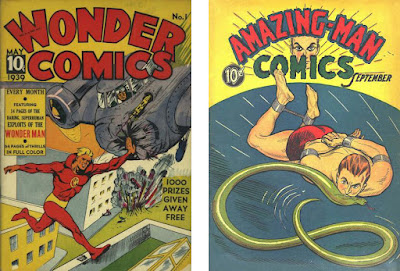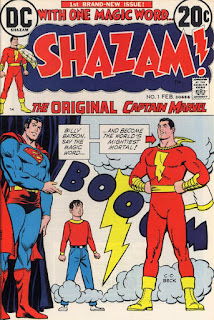THE ORIGINS OF CAPTAIN MARVEL ARE MIRED in a minefield of trademark and copyright legal battles, some ill-advised, most poorly handled. But that acrimonious history between DC Comics' Harry Donefeld and Jack Liebowitz, sleaze publisher Myron Fass and Marvel publisher Martin Goodman ultimately brought us to the Carole Danvers version of the character.
It was 1967, and Marvel publisher Martin Goodman had noticed a superhero comic on the newsstands called "Captain Marvel". Though Goodman had no legal case against "Captain Marvel" publisher Myron Fass, it must have irked him to see his by-then hugely success "Marvel" trademark being used by a low-level bottom-feeder like Fass ... especially given the involvement of Carl Burgos, who was engaged in suing Goodman over the ownership the Human Torch character.
So Goodman first tried to negotiate with Fass to see if he could acquire the name legally. Fass turned down Goodman's offer of $6000. It's hard to know why because Fass later admitted to the Wall Street Journal that the comic was selling an average of 100,000 per issue from a 250,000 print run, a rather poor 40% sell-through (and significantly below breakeven).
In any event, Goodman wasn't deterred and, probably thinking that Fass didn't have any trademark on the character, ordered Marvel Stan Lee to come up with a Marvel take on the character name. Still strait-jacketed by the unfavourable distribution deal he'd been forced to sign with Jack Liebowitz and Independent News, Goodman had nowhere to park his Captain Marvel except within the pages of his reprint title Fantasy Masterpieces. Hastily rebranded as Marvel Super-Heroes, a title he'd published a year earlier to tie-in with the Marvel Super-Heroes animated tv show, the new Captain Marvel hit the stands in October 1967. Fass must've gotten wind of Goodman's plans and had quickly printed the final issue of his Captain Marvel ("... Presents the Terrible Five") in September 1967, exactly a year after the character had last been on the stands.
As it turned out, Fass had taken out a trademark registration, and sued Goodman (also naming Marvel Comics, Stan Lee, Gene Colan and Eastern Color Printing, along with Independent News) for infringement. The matter was finally resolved out of court, with Goodman paying Fass $4,500 for the Captain Marvel trademark. Shoulda taken the six grand, Myron ...
THE BIG RED CHEESE
The acrimony surrounding the comic character name of "Captain Marvel" goes back a lot further than Martin Goodman and Myron Fass. Dial back to 1938. A new character from Detective Comics Inc, Superman, was already setting the publishing world alight. Sales were booming, despite the doubts of Detective Comics publisher Harry Donenfeld, who had ordered the character off the covers of Action Comics after issue 1. By the time he realised his mistake, Action Comics was already up to issue 7 (Dec 1938)
If the other comics publishers needed some sort of sign that the future was in long-underwear characters, Donenfeld had just given them one. Even so, Detective Comics was slow to act on its own intelligence. Superman didn't return to Action covers until issue 13 (Jun 1939). It was that same month that Superman 1 appeared. The character next showed up on the cover of Action 15 (Aug 1939), and with 16 (Sep 1939), Superman began appearing in the top left corner of every Action cover. And that was likely the catalyst that galavanised Fawcett Publications into pulling together their own answer to Superman.
There had already been a couple of Superman copycats ... earlier in 1939, Will Eisner had cobbled together a quickie rip-off character for Fox Comics, Wonder Man. The character managed one appearance in Wonder Comics 1 (May 1939, on sale in mid-March) before the wrath of Harry Donenfeld came crashing down upon them, and Wonder Man was never seen again.
The other superhero from around this time was Amazing Man, often mentioned as another Superman clone, though I don't see it. Created by Bill Everett, for Centaur Comics, with some input from art director Lloyd Jacquet, Amazing Man first appeared in Amazing Man Comics 5 (Sep 1939, on sale mid-August). The character's origin sounds more like Doctor Strange than Superman (trained to superhuman level by Tibetan monks) and his power seems to be just invisibility. The claim that he was a Superman clone probably comes from a quote from a letter written by Everett's mother Grace that says, "I’m going to spend all day tomorrow at the Public Library, doing some research work for Bill. He has a new character, for a strip which Jacquet wants him to do in competition with the new one now being syndicated – called the 'Superman' I think. We’ve wracked our brains for a new kind of character; and all I can think of now is to back over some old folk tales, foreign ones if necessary, and try to find some unusual character around which we can build an unusual story for these modern times." Amazing Man would continue, undisturbed by Donenfeld's litigious Detective Comics until Amazing Man Comics 26 (Jan 1942). Fawcett's stab at a superhero wouldn't be quite so lucky ...
Fawcett Publications was founded in 1919 by by Wilford "Capt Billy" Fawcett, with their first publication, Capt Billy's Whiz Bang. Pretty soon, the company had a monthly circulation of 10 million per month, spread across several publications, including Mechanix Illustrated, Family Circle and True Confessions. And in 1939, Fawcett decided to get into the comics business.
Newly-installed staff writer Bill Parker began mapping out a roster of characters that would feature in the company's first 64-page anthology title, tentatively titled Flash Comics. The initial lineup included Dan Dare (no relation), Scoop Smith, The Golden Arrow and Lance O'Casey, along with costumed characters Ibis the Invincible and Spy Smasher. But for the lead slot, Parker planned to showcase a team of superheroes, the first in comics, each granted his single power from one of the mythical Greek gods. Fawcett Executive Director Frank Daigh wasn't keen, preferring to have just the one hero with multiple powers, so Parker re-tooled his team into a single character, Captain Thunder, and Charles Clarence "C.C." Beck was hired to create a look for the character.
"When Bill Parker and I went to work on Fawcett's first comic book in late 1939, we both saw how poorly written and illustrated the superhero comic books were," Beck told Tom Heintjes in a 1980s interview. "We decided to give our reader a real comic book, drawn in comic-strip style and telling an imaginative story, based not on the hackneyed formulas of the pulp magazine, but going back to the old folk-tales and myths of classic times." And that's an important point for later ... Superman was very much a science fiction character and Captain Marvel was rooted in myth and magic.
And ashcan copy of the new Flash Comics, sporting Captain Thunder on the cover, was prepared to secure copyrights on the titles and characters, but DC beat Fawcett to the punch by getting their ashcan of Flash Comics out first.
 |
| Back in the early days of comics, "ashcan" editions were published, sometimes just the single copy, to secure a legal claim to a title by virtue of being first. |
Undeterred, Fawcett revamped their Flash Comics into Thrill Comics and tried again. But guess what? Yup, another publisher, Ned Pines' Better Publications, came out with Thrilling Comics.
 |
| Though different, Fawcett management probably thought Thrill Comics was too close to Thrilling Comics and, ironically, wanted to avoid a lawsuit. |
But third time's a charm, right? Another change of logo and artwork and Fawcett finally came out with Whiz Comics, featuring Captain Marvel on the cover in an alternate take on the famous Action Comics 1 cover art.
 |
| Accident or design? Both characters' first appearances involved them hurling automobiles, a surefire way of letting readers know that the character was stronger than any normal human. |
The early Superman stories in Action Comics concentrated on societal ills. Superman was shown slapping a wife-beater around in the very first ever story. By contrast, Captain Marvel went with whimsy and this fresh take was an instant hit with younger readers.
Six months in and Captain Marvel had his own title, something it took Superman nearly twice as long to achieve. Captain Marvel Adventures went monthly with its sixth issue (Jan 1942). Superman remained bi-monthly until the beginning of 1954, when it went to eight times a year. So you can see why National Periodicals might feel a bit threatened by this upstart.
Even more galling for DC/National ... when Republic Studios came looking for a superhero to feature in one of their Saturday morning chapterplays, DC were playing hard-to-get, so what should have been a Superman serial became The Mysterious Dr Satan, featuring a substitute hero, Copperhead.
Strangely undeterred, Republic took another swing at a Superman serial, but DC/National's executive editor Whitney Elsworth proved as difficult to deal with as ever and, finally losing patience altogether, Republic simply approached Fawcett and licenced Captain Marvel for a serial instead ... and that, more than anything else I think, triggered the start of the DC lawsuits in 1941.
After a lot of back and forth - and probably thousands in legal fees - the case came to trial in 1948. In 1951, the presiding judge decided that because DC/National had failed to secure the correct copyrights on their newspaper strips of Superman, they were deemed to have abandoned the ownership of the Superman character, and Fawcett were free to continue with Captain Marvel.
National appealed, of course, and in reviewing the case a new judge ruled that though he didn't consider Captain Marvel, per se, an infringement on Superman, some of Marvel's super-feats could be, and sent the matter back to the lower courts for retrial.
 |
| It took him a few years, but Superman editor Weisinger did transform his Superman franchise into the kind of multi-book affair that the Marvel Family had commanded in the previous decade. |
But with sales in post-war decline, Fawcett took the decision to settle with National and withdrew Captain Marvel - and the legion of spin-offs and related characters - from the newsstands in 1953. Could it be coincidence that around the same time, DC's Dark Overlord Mort Weisinger began expanding the Superman mythos to include super-pets and super relations, like Krypto, Supergirl, and giving supporting characters Jimmy Olsen and Lois Lane their own books?
DC/National eventually bought the rights to publish Captain Marvel themselves, but when they brought out the revived character in 1973, they couldn't call the book "Captain Marvel" as Marty Goodman's Marvel Comics owned the trademark on that name.
Which sort of brings us full circle ...
Next: Will the real Captain Marvel please stand up?









This story has annoyed me since I first read about it. Fawcett's Captain Marvel comics were so good, somehow they should have been allowed to continue and prosper. This good guy should have won in 1953.
ReplyDelete